Intel Details Manufacturing through 2023: 7nm, 7+, 7++, with Next Gen Packaging
by Ian Cutress & Anton Shilov on May 8, 2019 4:35 PM ESTAt Intel's Investor Day today, CEO Bob Swan and Murthy Renduchintala spoke to the ability of the company with respect to its manufacturing capabilities. Intel has historically been strong in its ability to execute on its process technology, however the delay of its 10nm process has obviously raised multiple question marks, and has done for several years. The two Intel executives went into a little detail about what Intel was doing in the interim, and how it has learned from the issues.
Back in 2013, Intel envisoned its 10nm to succeed the 14nm by providing 2.7x density, with new technologies such as Self-Aligned Quad Patterning (SAQP), Contact over Active Gate (COAG), Cobolt Interconnects, and new packaging technologies such as EMIB and Foveros. Intel admits that this was an ambitious plan, and the goals were not clearly defined with the teams and it was ultimately overly complex and not managed in an ideal way.
This ended up pushing 10nm out into a later time frame. In this case, Intel pushed 10nm out to 2019 (technically they shipped Cannon Lake in small quantities on 10nm in 2017, however that is nothing more than a curio in the timeline of semiconductors), and filled the gap with 14+ and 14++.
Intels 14+ and 14++ processes extracted more than 20% more performance (from Broadwell to Whiskey Lake) from the process since its inception. As a result, Intel is prepared to not only get ready for future intra-node optimizations, but actually adjust the roadmap to compensate for it. Murthy made it clear that Intel wants to introduce a Moore's Law-like gain at the beginning of a new process, and another similar gain by the end of the process.
Intel has stated that its 10nm product family (beyond Cannon Lake) will start to be available from the middle of this year (2019), with Ice Lake on client platforms (notebooks).
Intel will be launching multiple 10nm products through 2019 and 2020, including server based 10nm in the first half of 2020:
In the above slide, Intel states that it will have 7nm in production and launching a product in 2021. That sounds very aggressive for a company that has had issues with 10nm. It even shows in Intels radmap, with 10nm (and 10+ and 10++) having a much shorter life cycle than the 14nm family of processes.
With this in mind, Intel's 7nm is going to be the combination of what Intel has learned from the 14nm and 10nm family of products. Intel wants that 2x scaling (Moores Law), but with intra-node optimations planned as part of the roadmap. Intel is also reducing its number of design rules, which should help with execution. 7nm will also be where Intel intersects with EUV, and also introduce next-gen Foveros and EMIB packainging.
Intel provided this slide, which shows a monolithic PC-Centric die with a multi-die Data-Centric chip built on both Foveros and EMIB. This corroborates our discussion with Intel's chiplet and packaging team, who also stated that we would see Foveros and EMIB on a combined product - specifically the GPU.
Intel announced that its lead 7nm product (lead = top, or lead = first?) would be its new GPGPU, built on the Xe graphics architecture. Intel has stated that its Xe product stack will feature two different microarchitectures from mobile client up to GPGPU, with one of those architectures called Arctic Sound - technically Intel will launch its first discrete GPU in 2020 according to its press release, however the 7nm GPGPU will be launched in 2021.
More information is coming out of Intel's Event, more to follow.
Related Reading
- Intel: EUV-Enabled 7nm Process Tech is on Track
- Intel Starts Qualification of Ice Lake CPUs, Raises 10nm Volume Expectation for 2019
- Intel Agilex: 10nm FPGAs with PCIe 5.0, DDR5, and CXL
- Intel to Equip Fab 42 for 7 nm
- Intel Discloses Plans to Spend $5 Billion on Fab 28 Expansion in Israel
- Intel Submits Ireland Fab Expansion Plan: $8 Billion Price Tag, With a 4 Year Lead Time
- Intel Details Plans for Its Oregon Fab Expansion: D1X Phase 3
- Intel to Expand Production Capacities at Multiple Fabs
Source: Intel


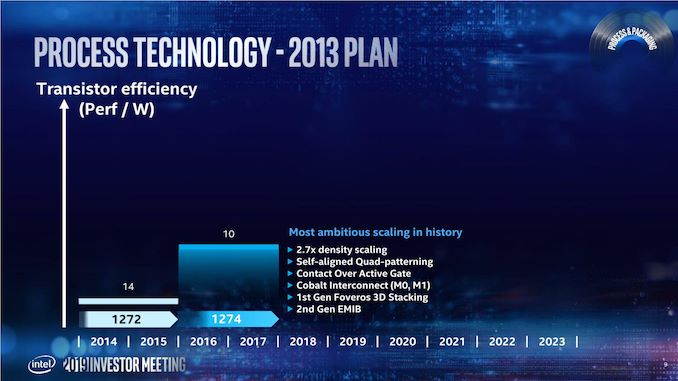

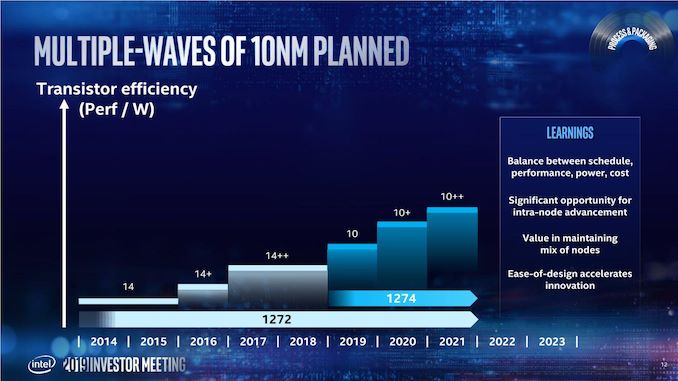
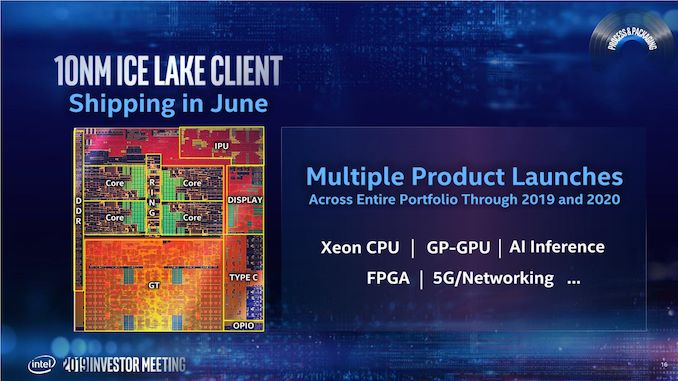
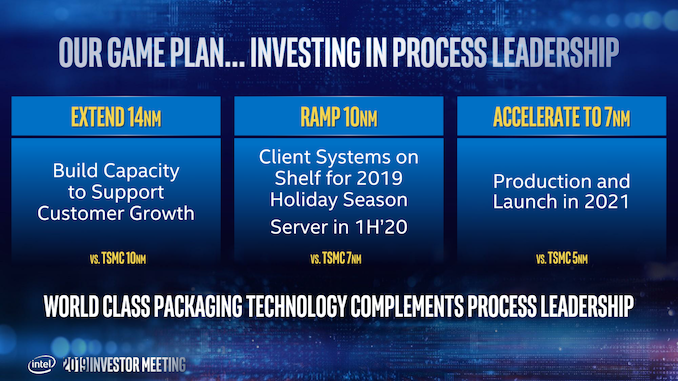
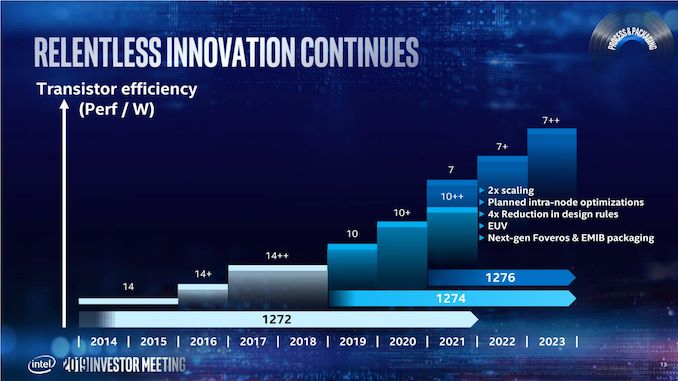

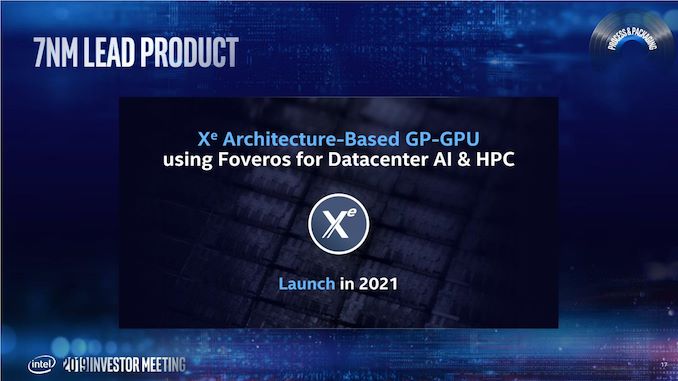








237 Comments
View All Comments
Jorgp2 - Wednesday, May 8, 2019 - link
2x the GPU performance seems underwhelming.FreckledTrout - Wednesday, May 8, 2019 - link
Intel will have 7nm in 2021 which is going to be similar to TSMC's 5nm which is already in risk production? Crazy to see Intel behind in process tech. Is Intel's 7nm process going to use GAAFET or will it still be FinFET? I do wonder if Intel is going to hit similar issues with 7nm FinFET scaling up frequencies like they did with 10nm using quad patterning.Yaldabaoth - Wednesday, May 8, 2019 - link
"Learnings"Really, Intel?
SaturnusDK - Wednesday, May 8, 2019 - link
So Intel 7nm will compete against TSMC 5nm+ and Intel 7nm+ (or 7nm++) will compete against TSMC 3mn.Doesn't look like Intel is going to catch up to the competition any time soon, if at all.
Opencg - Wednesday, May 8, 2019 - link
in terms of performance / price it probably wont make a huge difference outside of power limited and poorly cooled mobile products. look at nvidia rtx vs radeon vii. they offer roughly the same performance on different nodes at the same consumer price.Irata - Friday, May 10, 2019 - link
The thing is that Intel has so far always been ahead a node (or even two) of the competition - even now. This did give them lower power consumption, higher clocks and more room for additional features on the die.This will only change once AMD releases Ryzen 3000 on 7nm.
HStewart - Wednesday, May 8, 2019 - link
Maybe some people are to young to remember the frequency wars of Pentium 4 vs AMD days. nm from two different foundries maybe is different performance all together.Korguz - Thursday, May 9, 2019 - link
yes.. and guess what HStewart... intel LOST that Mhz war .... didnt they ??Opencg - Thursday, May 9, 2019 - link
did they though? I mean its kindof a stupid thing to talk about in the first place. pentium 4 era intel was known for winning the mhz war but having much worse "ipc" than amd. so korguz i guess that makes you wrong and then wrong again for even bringing it up. lolKorguz - Thursday, May 9, 2019 - link
Opencg.. actually.. AMD did win the mhz war.. they were the 1st to the 1 ghz mark... while intel still had the better IPC so maybe we are thinking different wars ? hehehehe